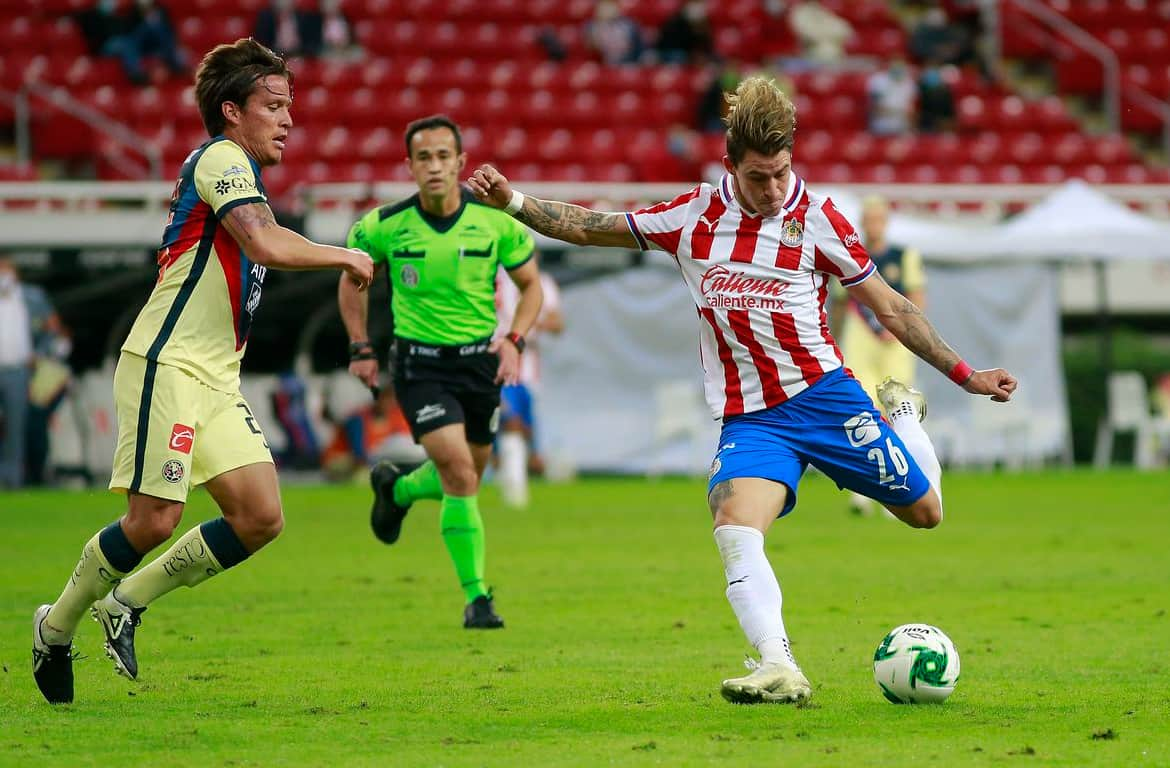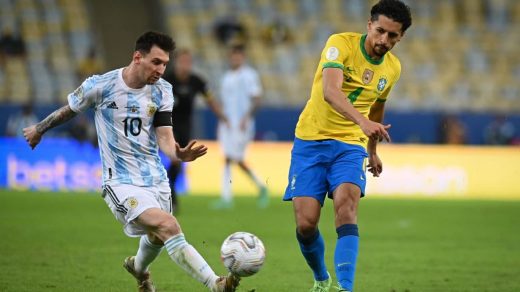When it comes to Mexican football, few matchups capture the passion, intensity, and history of the game quite like the fierce rivalry between Chivas de Guadalajara and Club America.
Known as El Clásico Nacional, this epic clash pits two of the country’s most successful and beloved teams against each other in a battle for bragging rights and supremacy.
At the heart of this legendary encounter lies the crucial importance of the Chivas de Guadalajara vs Club America lineups.
The starting eleven selected by each manager can often determine the outcome of the match, with tactical decisions, player form, and squad depth all coming into play.
From the fearsome attacking prowess of Chivas’ frontline to the resolute defensive strength of America’s backline, every position on the pitch takes on added significance in this high-stakes affair.
In this article, we will take an in-depth look at the key players, tactical battles, and historical context that make the Chivas de Guadalajara vs Club America lineups such a fascinating and integral part of this iconic rivalry.
Chivas de Guadalajara vs Club America Lineups

In this in-depth guide, we will explore how the tactical approaches of both teams have evolved over the years, analyze their contrasting youth development systems, and examine the broader cultural impact of this iconic rivalry.
Tactical Evolution
Throughout the history of El Clásico Nacional, Chivas and America have employed a wide range of tactical systems and styles of play, each reflecting the preferences of their coaches, the strengths of their squads, and the broader trends in Mexican and world football.
Chivas de Guadalajara
Traditionally, Chivas has been associated with a classic Mexican style of play, emphasizing technical skill, short passing, and fluid movement.
However, in recent decades, the team has adapted to the demands of modern football, incorporating elements of pressing, counter-attacking, and direct play into their tactical approach.
Some of the most notable tactical eras in Chivas’ history include:
- The 1970s and 1980s: Under coaches like Alberto Guerra and Manuel Sañudo, Chivas employed a fluid, possession-based style, with short passing triangles and a focus on creativity and individual skill.
- The 1990s and 2000s: Coaches like Luis Flores and Jesús Bracamontes introduced a more pragmatic, defense-oriented approach, with a focus on organization and counter-attacking.
- The 2010s and 2020s: In recent years, Chivas has embraced a more modern, high-pressing style, with coaches like Matías Almeyda and Víctor Manuel Vucetich emphasizing intensity, verticality, and quick transitions.
Throughout these tactical evolutions, Chivas has remained committed to its core philosophy of developing and fielding Mexican players, adapting their style of play to suit the strengths and characteristics of their homegrown talents.
Club America
As a club with a more cosmopolitan outlook and a willingness to sign foreign players, America has often been at the forefront of tactical innovation in Mexican football, adopting and adapting the latest trends and systems from around the world.
Some of the most significant tactical eras in America’s history include:
- The 1960s and 1970s: Under legendary coaches like Fernando Riera and Ignacio Trelles, America employed a sophisticated, possession-based style, with an emphasis on individual skill and creative freedom.
- The 1980s and 1990s: Coaches like Carlos de los Cobos and Leo Beenhakker introduced a more structured, defense-oriented approach, with a focus on organization, discipline, and counter-attacking.
- The 2000s and 2010s: Under coaches like Manuel Lapuente and Miguel Herrera, America adopted a more aggressive, high-pressing style, with an emphasis on quick transitions, verticality, and attacking flair.
Throughout these tactical evolutions, America has leveraged its financial power and global appeal to attract top talent from around the world, building squads that can adapt to and execute a wide range of tactical systems.
Player Development
One of the key factors that set the Chivas vs America rivalry apart is the contrasting approaches of both clubs to player development and squad building.
Chivas de Guadalajara
Chivas’ commitment to fielding only Mexican players has made the club a bastion of homegrown talent development. The club’s youth academy, known as La Cantera, has produced some of the greatest players in Mexican football history, including:
- Salvador Reyes: Considered one of the best Mexican players of all time, Reyes spent his entire career at Chivas, winning multiple league titles and serving as a symbol of the club’s commitment to homegrown talent.
- Ramón Ramírez: A legendary midfield playmaker, Ramírez came up through the Chivas youth system and went on to become one of the club’s all-time greats, known for his technical skill and creative vision.
- Javier Hernández: “Chicharito” Hernández began his career at Chivas before going on to success in Europe, becoming a symbol of the club’s ability to develop world-class talent.
Chivas’ focus on youth development has not only produced great individual players but has also contributed to a distinct team identity and style of play, with an emphasis on technical skill, creativity, and a strong work ethic.
Club America
In contrast to Chivas’ homegrown approach, America has traditionally relied on a mix of top Mexican players and high-profile foreign signings to build their squads.
However, in recent years, the club has also invested heavily in youth development, with their academy producing several promising talents.
Some of the most notable products of America’s youth system include:
- Raúl Jiménez: A powerful, technical striker, Jiménez came up through the America academy before going on to success in Europe with Benfica and Wolverhampton Wanderers.
- Edson Álvarez: A versatile defensive midfielder, Álvarez emerged from the America youth ranks to become a key player for both club and country before moving to Ajax in 2019.
- Diego Lainez: A skilled, creative winger, Lainez broke into the American first team as a teenager and is considered one of the most promising young players in Mexican football.
While America’s approach to player development may be less ideologically driven than Chivas’, the club’s increasing focus on homegrown talent has added a new dimension to the Clásico Nacional rivalry, with both teams now fielding squads that blend youth and experience, local and foreign talent.
Cultural Impact
Beyond its significance within the world of football, the Chivas vs America rivalry has also had a profound impact on Mexican culture and society, reflecting and shaping broader social, economic, and political trends.
Regional and Class Divides
One of the key factors that have fueled the intensity of the Chivas vs America rivalry is how it reflects regional and class divides within Mexican society.
Chivas, based in the city of Guadalajara, has traditionally been seen as the team of the working class and the provinces, while America, based in the capital Mexico City, has been associated with the urban elite and the establishment.
These regional and class divides have often taken on a political dimension, with Chivas seen as representing a more nationalist, populist outlook, while America has been viewed as a symbol of the cosmopolitan, globalized elite.
National Identity and the Mexican-Only Policy
Chivas’ historic policy of fielding only Mexican players has also given the club a unique place in the country’s cultural landscape.
For many Mexicans, Chivas represents a bastion of national identity and pride, a team that embodies the best qualities and characteristics of the Mexican people.
This Mexican-only policy has often been a source of controversy, with some critics arguing that it limits the club’s competitiveness and perpetuates a narrow, exclusionary vision of Mexican identity.
However, for Chivas fans, the policy is a source of immense pride and a key part of the club’s identity and appeal.
Globalization and the Changing Face of Mexican Football
In recent decades, the rise of globalization and the increasing influence of foreign cultures and ways of life have had a profound impact on Mexican society, including in the world of football.
The influx of foreign players and coaches, the growing influence of European and North American clubs, and the rise of new commercial and media forces have all contributed to a changing landscape in Mexican football.
In this context, the Chivas vs America rivalry has taken on new layers of meaning, with Chivas often seen as representing a more traditional, locally rooted vision of Mexican football, while America has come to embody a more modern, globalized approach.
Also Check:
- Georgia Bulldogs Football vs Texas Longhorns Football Match Player Stats
- Brazil National Football Team vs Argentina National Football Team Lineups
Conclusion:
The Chivas de Guadalajara vs Club America rivalry is more than just a football rivalry; it is a cultural touchstone, a reflection of the complex and often contradictory forces that shape Mexican society.
Through their contrasting approaches to tactics, player development, and cultural identity, Chivas and America have come to represent different visions of what Mexican football can and should be.
As the two clubs continue to evolve and adapt to the changing landscape of Mexican and world football, their rivalry will undoubtedly take on new dimensions and meanings.
However, one thing is certain: the passion, intensity, and cultural significance of El Clásico Nacional will endure, cementing its place as one of the greatest and most iconic rivalries in the world of football.
For fans of Chivas and America, as well as for lovers of Mexican football more broadly, the Clásico Nacional will always be more than just a game.
It is a symbol of the deep roots and rich history of the sport in Mexico, a reflection of the hopes, dreams, and divisions of a nation, and a stage upon which the future of Mexican football is constantly being written and rewritten.
As we look to the future of this iconic rivalry, we can be sure that it will continue to evolve and adapt, reflecting the changing face of Mexican society and the enduring power of football to unite, inspire, and transform.
Whether you bleed red and white or yellow and blue, the Chivas vs America rivalry is a testament to the unmatched passion and intensity of Mexican football and a reminder of the vital role that sport plays in shaping our cultural identity and collective imagination.


